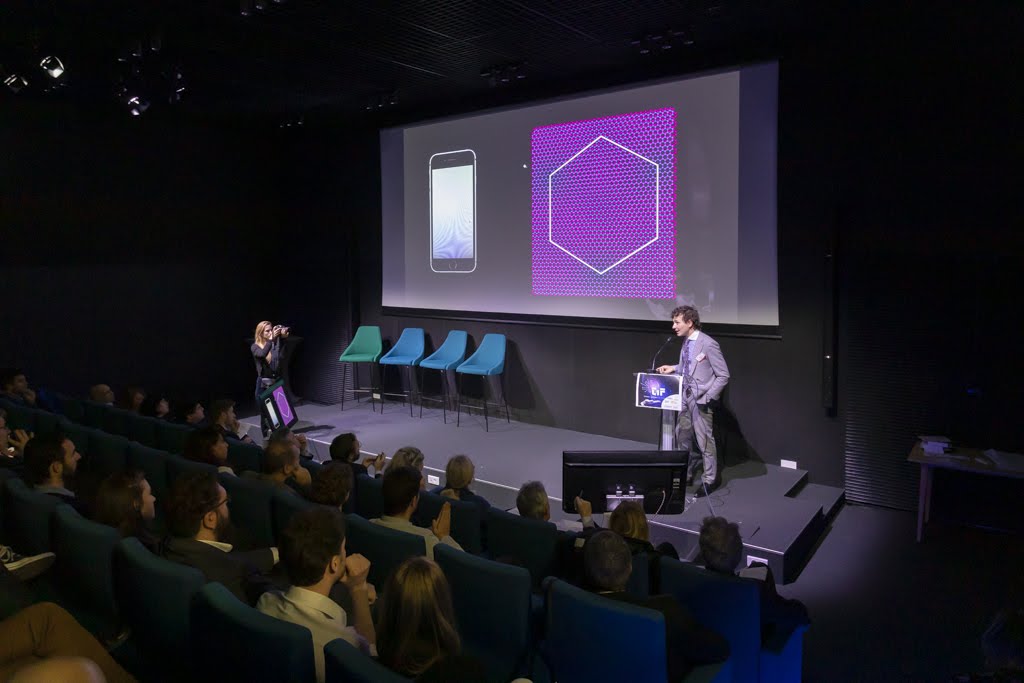At the end of last year, I receive the prize of the engineer for the Future from the French magazine l’Usine Nouvelle, foreshadowing some of the work I’m carrying out for my thesis.
That was for me the occasion to talk about Moiré lattices. I had planned to give a similar talk for the three minute thesis challenge but because of the covid-19 outbreak, this been cancelled. I now think this is a good occasion to develop this here.

I started the presentation in December by giving the example of a screen picture: if you take a photography of your screen, you’ll see a wavy pattern, due to the fact the pixels of your phone are misaligned with the pixels of the pictured screen. This is called a moiré, and there are lots of other occurrences of such a pattern in real life.
In condensed matter physics, moiré have skyrocketed over the past two years, as technology now enables to stack incommensurate layers of different 2D materials. For example, combining graphene with hexagonal boron nitride (that has the same honeycomb pattern than graphene, but 2% larger), create another periodicity, with a unit cell on the order of 10nm, that is 100 times larger than the graphene unit cell. We aim at characterising the behaviour of phonons, electrons, excitons and other quasiparticles in this kind of superlattices, and eventually discover new states of matter.
Second-generation Dirac fermions and the Hofsdtater’s butterfly.
The creation of moiré superlattice increases the lattice constant hence reduces the size of the Brillouin zone. For the Dirac spectrum of graphene, it duplicates the structure at higher filling, that we call second-generation Dirac fermions (Yankowitz 2012). In a magnetic field, superlattices made with aligned hBN enabled the observation the fractal Hofstadter’s butterfly spectrum, via the formation of third-generation neutrality points at high magnetic fields. This fractal pattern can notably be described by the Diophantine equation n/n₀ = t 𝚽/𝝓₀ + s, where n/n₀ is the normalised carrier density, with n₀ = 1/Asl, Asl being the superlattice unit cell area, and 𝚽 the magnetic flux per unit cell, 𝝓₀ the magnetic flux quantum, t and s integers. (Ponomarenko 2013, Dean 2013, Hunt 2013, Yu 2014)
Brown-Zak oscillations, or magnetic Bloch states
A more recent examples include the discovery of so-called Brown-Zak oscillations, that are conductivity oscillations occurring at flux fractions 𝚽/𝝓₀ = p/q, where p and q are integers. This is analogous to the Bloch theorem, as whenever the magnetic length has the size of the unit cell, the electronic wavefunction accommodates the periodicity of the lattice and carriers behave as if there were no magnetic field (Beff = 0). In superlattices made of graphene and hBN, the lattice constant of the Moiré is on the order of 10nm, allowing the observation of such states at magnetic fiels on the order of 20T. (Krishna-Kumar 2017 & 2018) One of the project I have been working on recently aims at characterising the new metallic states created in these Brown-Zak oscillations.
Graphene with a twist
For graphene-graphene twisted bilayers, other effects have been reported. The most famous is now the presence of superconducting domes between Mott insulating states, discovered by Cao et al in the MIT group. If the angle between the two graphene layers is much reduced, the size of insulating domains increases and allows the current to flow in 1D channels. Xu, Berdyugin et al, in our group have notably observed an Aharonov-Bohm effect, where carriers are transported through a triangular network and can interfere together, as in the case of the optical Young slits experiment. This leads to oscillations, with a periodicity in magnetic field intensity, that is a function of the angle between the two layers.
These are only a few examples of what becomes possible by stacking two atomically-thin layers together; the future may be even brighter in this field of physics.
References:
- Yankowitz et al 2012, Emergence of superlattice Dirac points in graphene on hexagonal boron nitride, Nature Physics
- Ponomarenko et al 2013, Cloning of Dirac fermions in graphene superlattices, Nature
- Dean et al 2013, Hofstadter’s butterfly and the fractal qunatum Hall effect in moiré superlattices, Nature
- Hunt et al 2013, Massive Dirac Fermions and the Hofstadter Butterfly in a van der Waals heterostructure, Science
- Yu et al 2014, Hierarchy of Hofstadter states and replica quantum Hall ferromagnetism in graphene superlattices, Nature Physics
- Krishna-Kumar et al 2017, High-temperature quantum oscillations caused by recurring Bloch states in graphene superlattices, Science
- Krishna-Kumar et al 2018, High-order fractal states in graphene superlattices, PNAS
- Xu, Berdyugin et al, 2019, Giant oscillations in a triangular network of one-dimensional states in marginally twisted graphene, Nature Communications
 0000-0002-6484-2157
0000-0002-6484-2157